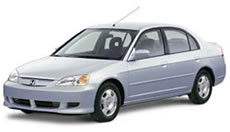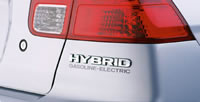Eco-Friendly
Option
The 2003 Honda Civic Hybrid
by
Philip Raby

It
is possible to make your neighbors green with envy in Honda's latest
eco-friendly addition to the popular Civic line-up?
Well, yes
and no.
You may
feel morally superior zipping about town in your new gas-sipping compact,
but not many people will understand the reason for your newfound smugness.
That's because Honda's 2003 Civic Hybrid is so much like an ordinary
car, that few people would ever know you're driving a vehicle equipped
with the latest in ultra-low emission technology.
That means
you'll just have to brag about it. And if your friends are easily impressed
with technical jargon, you can tell them that the Hybrid is powered
by Honda's innovative Integrated Motor Assist (IMA) system, coupled
with a continuously variable transmission (CVT).
Basically,
that means the Hybrid's primary power source is a 1.3-liter, four-cylinder
gas engine. But when extra boost is needed on acceleration, an electric
motor kicks in to provide added horsepower. Think of it as a gas motor
with an electric turbo.
The CVT
is a revolutionary piece of automotive technology that abandons the
usual transmission gears in favor of two metal cones. The system works
by varying the position of a high-strength steel belt between the cone.
One cone connects to the power input of the transmission and the other
connects to the power output side of the transmission. Through various
guides within the transmission, the belt can slide up and down the cones
to create the most suitable gear ratio for any speed and throttle input.
The end results for drivers are smooth, seamless shifts, better torque
and improved fuel efficiency. But for those who prefer a stick, a five-speed
manual transmission is also offered on the U.S. model.
There are
some other neat ideas at work here too. Each time the car comes to a
complete stop at traffic lights, stop signs or even in gridlock, the
gas engine shuts down to save fuel and reduce pollution. The batteries
pick up the slack to keep the radio, lights, turn signals and even the
air conditioning powered. Then, as soon as the brake pedal is released,
the gas motor quietly comes back to life with the aid of the electric
motor.
The only
time the automatic idle stop feature disengages itself is when the AC
is on and the driver has not selected the econo mode. In that event,
the gas engine will keep running to prevent the air conditioning from
drawing too much power.
Another
gas saving feature kicks in when coasting. The Hybrid uses Honda's clever
VTEC technology to shut down up to three of the four cylinders for added
fuel economy and charging of the nickel-metal hydride batteries.
Best of
all, unlike what we've come to expect from electric technology, there
is no need for external charging. The Hybrid cleverly charges itself
every time you apply the brakes (what the engineers call "regenerative
braking").
Add to
this low rolling resistance tires and a functional rear spoiler and
front air dam to reduce drag, and you've got yourself a lean, mean driving
machine.
 So
how does it drive? Well, pretty much like any other Civic on the road.
It's well mannered yet spirited, ergonomically friendly and roomier
than you might expect. And despite the small engine, it cruises effortlessly
at normal highway speeds and even above with very little noise. In fact,
the car is eerily quiet pretty much all of the time. So
how does it drive? Well, pretty much like any other Civic on the road.
It's well mannered yet spirited, ergonomically friendly and roomier
than you might expect. And despite the small engine, it cruises effortlessly
at normal highway speeds and even above with very little noise. In fact,
the car is eerily quiet pretty much all of the time.
One of
the only concerns noted with the car's behavior is its tendency to roll
backwards on inclines when the brake is released from a dead stop. This
is expected with the manual transmission, but comes as a surprise at
first with the automatic engine. However, once you get used to that
fact and learn to anticipate it, you can quickly put it behind you.
Another
minor annoyance is the effect that the regenerative charging system
has on the braking. You may find it difficult to brake smoothly as the
batteries take what energy they can from slowing engine.
Once inside the cabin, however, everything is very smooth. All the modern
conveniences are standard, including power locks and windows, CD player
and air conditioning with automatic climate control and micron filtration.
Honda has also furnished the Hybrid with top quality fit and finish.
The only compromise to the electric assist is the lack of a folding
rear seat. This was necessitated by the well-concealed batteries that
sit just behind the rear bench. Still, five adults can fit into the
car and remain relatively comfortable, thanks to the flat floor in the
back and the firm support of the seats.
One other
minor difference between the Hybrid and regular Civics is the glowing,
blue digital readout, which informs the driver of whenthe electric
motor is assisting the gas engine or re-charging itself. This is a neat
feature, though somewhat distracting until you get over the novelty.
The display
also keeps tabs on the current charge level of the batteries and your
gas mileage. Speaking of which, the Hybrid boasts a highway mpg of 51
and 46 in the city. That's about 30 per cent more efficient than the
normal 1.7-liter engine found in the regular Civic.
 But
when you come right down to it, the unique dashboard display and he
inconspicuous badging on the trunk are the only items that outwardly
declare the car's enviro-friendly concept. All of which begs the question,
if you're going to spend $19,550 for a Honda Civic, don't you want it
to scream, "Look at me, I'm green!" But
when you come right down to it, the unique dashboard display and he
inconspicuous badging on the trunk are the only items that outwardly
declare the car's enviro-friendly concept. All of which begs the question,
if you're going to spend $19,550 for a Honda Civic, don't you want it
to scream, "Look at me, I'm green!"
Fortunately,
for American drivers, there's economy to be found even beyond the incredible
gas mileage. Civic Hybrid owners can qualify for a $2,000 federal clean-fuel
vehicle tax deduction.
Still though,
this vehicle is not for the average economy car purchaser. You have
to want to make a statement (albeit a subtle one) and do your part for
the environment. However, it is a pleasant and rewarding way to do just
that.
For more
information on the 2003 Honda Civic Hybrid, click here.
|